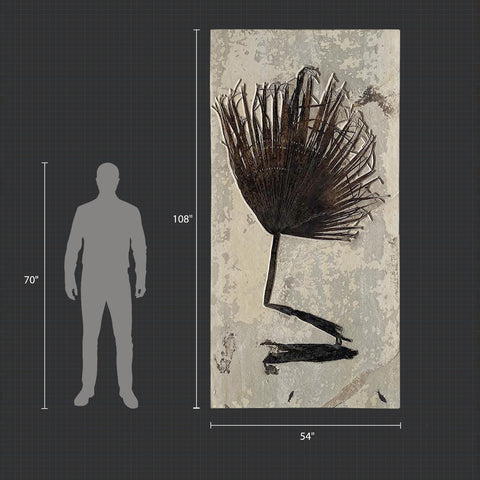VS #3 - Monumental Pyritized Crinoid
Price on Request
This extraordinary crinoid specimen, preserved in shimmering pyrite, originates from the renowned Posidonia Shale of Holzmaden, Germany—an iconic fossil site celebrated for its unparalleled preservation. Measuring nearly six feet across, this piece stands out for its monumental scale, exceptional detail, and sculptural visual impact.
The crinoid itself—a large Seirocrinus subangularis—is covered in a natural pyritic coating that catches the light with striking brilliance. Its long stem and beautifully fanned crown are spectacularly preserved, offering a dynamic glimpse into marine life from 180 million years ago.
Crinoids, though plantlike in appearance, are marine animals related to starfish and sea urchins. They once populated Jurassic seas teeming with ichthyosaurs, ammonites, and ancient fish. Remarkably, their lineage persists today in the form of “living fossils” still found in modern oceans.
In recent years, marine fossils have gained significant attention among fine art collectors, designers, and architects, often serving as natural centerpieces in luxury interiors. With its commanding presence, aesthetic refinement, and scientific significance, this piece is suited for both private collections and public exhibition.
Note: The specimen has been artistically inset into original shale matrix from Holzmaden.
Includes a custom-designed wall-mountable metal frame.
TAXONOMY
- Kingdom: Animalia
- Phylum: Echinodermata
- Class: Crinoidea
- Species: Seirocrinus subangularis
GEOLOGICAL CONTEXT
- Formation: Posidonia Shale
- Location: Holzmaden, Baden-Wuerttemberg, Germany
- Age: Lower Jurassic (approximately 180 million years old)
PHYSICAL CHARACTERISTICS
- Slab dimensions: 70.75 x 35.5 in (179.7 cm x 90.2 cm). - 1 large flowerhead, 20.5 inches
- Weight: 216 lbs (98 kg)
- Custom wall-hanging metal frame included
- Please contact us about shipping arrangements






